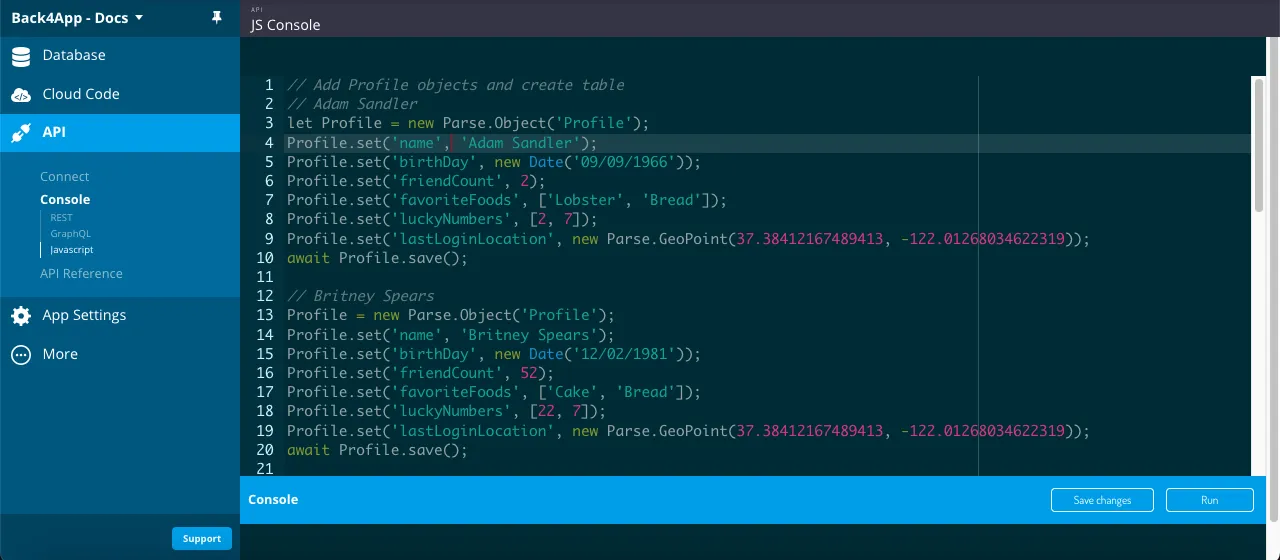Geoqueries
In this guide, you will learn about GeoPoint data type on Parse and how to perform geo queries in Parse using the Flutter geolocation. You will create an application that will perform geo queries and retrieve records using Parse Geopoints.
We won’t explain the Flutter application code once this guide’s primary focus is on the Flutter with Parse.
To complete this tutorial, you will need:
- An app created on Back4App.
- An Flutter app connected to Back4app.
- Note: Follow the Install Parse SDK on Flutter project to create an Flutter Project connected to Back4App.
- A device (or virtual device) running Android or iOS.
- In order to run this guide example you should set up the plugin Geolocator properly. Do not forget to add permissions for Android and iOS in order to access the device location {: .btn target=”_blank” rel=”nofollow noreferer noopener”} in the project. Carefully read the instructions for setting up the Android and iOS project.
Perform Geoqueries using geopoints stored on Back4App and Flutter geolocation.
Parse allows you to associate real-world latitude and longitude coordinates with an object. Adding a ParseGeoPoint to a ParseObject will enable queries to consider the proximity of an object to a reference point. This feature allows you to easily do things like finding out what user is closest to another user or which places are nearest to a user.
To associate a point with an object, you first need to create a ParseGeoPoint. Below you can find a geopoint with a latitude of 40.0 degrees and -30.0 degrees longitude.
This point is then stored in the object as a regular field, like any other data type (string, number, date, etc.)
** Note: Currently only one key in a class may be a ParseGeoPoint
Any Parse query operation uses the QueryBuilder object type, which will help you retrieve specific data from your database throughout your app. To create a new QueryBuilder, you need to pass as a parameter the desired ParseObject subclass, which is the one that will contain your query results.
It is crucial to know that a QueryBuilder will only resolve after calling a retrieve method query, so a query can be set up and several modifiers can be chained before actually being called. You can read more about the QueryBuilder class here at the official documentation.
Inside your Back4App application’s dashboard, you will find a very useful API console in which you can run JavaScript code directly. In this guide you will use to store data objects in Back4App. On your App main dashboard go to Core->API Console->Javascript.

To run the queries on this guide you’ll need first to populate your App with some data. Let’s create a City class, which will be the target of our queries in this guide. Here is the Parse.Object classes creation code, so go ahead and run it in your API console:
After running this code, you should now have a City class in your database. Your new class should look like this:

Let’s now take a look at examples from every QueryBuilder method, along with brief explanations on what they do.
Now that you have a populated class, we can now perform some GeoPoint queries in it.
Let’s begin by ordering City results by the nearest from Dallas in USA (latitude 32.779167, and longitude -96.808891), using the whereNear method:
Let’s now query using the method whereWithinKilometers, which will retrieve all results whose GeoPoint field is located within the max distance in Kilometers. Dallas will be used once again as a reference and the distance limit will be 3000 km.
Let’s now query using the method whereWithinMiles, which will retrieve all results whose GeoPoint field is located within the max distance in Miles. Dallas will be used once again as a reference and the distance limit will be 3000 miles.
Let’s now use our example queries inside a Flutter App, with a simple interface having a list showing results and also 3 buttons for calling the queries.
The app also retrieves the device’s current location using Geolocator plugin (follow the instructions), so the queries will be using real data.
Open your Flutter project, go to the main.dart file, clean up all the code, and replace it with:
Find your Application Id and Client Key credentials navigating to your app Dashboard at Back4App Website.
Update your code in main.dart with the values of your project’s ApplicationId and ClientKey in Back4app.
- keyApplicationId = App Id
- keyClientKey = Client Key
Run the project, and the app will load as shown in the image.

At the end of this guide, you learned how GeoPoint data queries work on Parse and how to perform them on Back4App from a Flutter App.